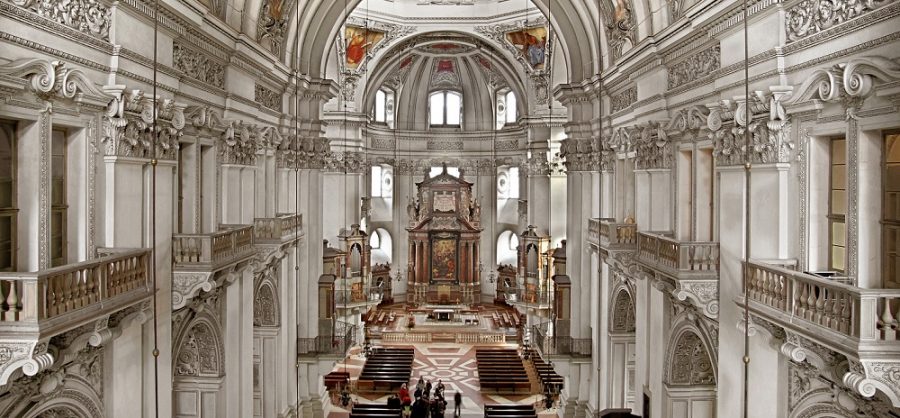

The South Oratory containing the permanent exhibition is on the same level as the great organ loft and the North Oratory opposite. Both oratories, which have balconies over the nave, are divided into four vaulted, stuccoed rooms. Each easternmost room is appointed as a chapel, with ceiling paintings dedicated to St Rupert (north) and St Virgil (south).
The principal exhibits are the liturgical utensils, many of which are still in use at Pontifical High Masses.
Outstanding Late Renaissance works dating from the reign of Prince-Archbishop Wolf Dietrich (1587–1612) include a disc ostensory (1596 – one of the earliest north of the Alps) and a Roman Missal with a splendid silver and enamel cover (1601/1603).
A century after the Wolf Dietrich Ostensory, Prince-Archbishop Johann Ernst Thun (1687–1709) ordered from his court goldsmith Ferdinand Sigmund Amende (1656–1731) the unique Precious Ostensory (1697) decorated with vines and studded with jewels.
The oldest and artistically most valuable object is the Cross of St Rupert (c 750), on loan from the parish church of Bischofshofen. Showing features of both Anglo-Saxon and Mediterranean art, the largest surviving Early Mediaeval metal cross may have been fashioned on Salzburg soil.
Further art treasures, from various churches and monasteries in the Archdiocese of Salzburg, are mainly Gothic and Baroque paintings and sculptures.
To listen to (audio guide)
“Cathedral Museum and Cathedral Treasure”
Salzburg Baroque is represented with works by well-known masters such as Meinrad Guggenbichler, Georg Raphael Donner, Johann Michael Rottmayr and Paul Troger. The best sculptures include Matthias Wilhelm Weissenkirchner’s (1670–1727) marble Madonna of St Cajetan’s Church (1726), whose emotive force is reminiscent of Bernini’s work.
Such cabinets with their original furnishings, as that in the south arcade of the Cathedral, are rare in Europe. The marble floor, stuccoed vaulting and showcases date back to the original archiepiscopal Cabinet, around 1668–1670.
After the dissolution of the Archbishopric in 1803, however, the original collection was lost to Salzburg. With the founding of the Cathedral Museum in 1974, the Cabinet was restored to its original function on the basis of the old inventories. The new Cabinet of Curiosities, with objects from the art market and loans from St Peter’s Archabbey and private collections, has assembled curiosities from nature, art and technology to illustrate what a 17th-century universal collection might have looked like.
To listen to (audio guide)
“The Cabinet of Curiosities ”
The Salzburg Cathedral Museum is comparatively recent. While the first diocesan museums in Austria were installed around 1890/1900, the Museum of the oldest diocese in modern Austria was opened only in 1974.
The Cathedral Museum is the refuge and the treasure-house of the Church in Salzburg. It houses the art-works of the Cathedral and the Archdiocese, contributes to research on them and makes them accessible to the public. It seeks to educate the public, to promulgate the faith and the identity of the Church, it communicates and represents the Archdiocese both internally and externally.
Situated in the South Oratory, the Museum also comprises the Cabinet of Curiosities in the south arcade. With their marble floors (c 1620) and stucco dating from the original construction (c 1660), the views of the Cathedral interior and over the surrounding squares, these rooms have a manifestly connective function between Cathedral and town. The Museum has formed part of the DomQuartier since 2014.
The collections comprise mainly art-works from the Salzburg Archdiocese and adjacent regions, dating from between the 8th and 18th centuries. As customary for an ecclesiastical museum, all genres of art are represented, with a focus on the decorative arts. The Cathedral treasure and the Cabinet of Curiosities offer special fields. Only a few of the art-works date from mediaeval times, so the picture of Salzburg Town and Province is markedly baroque.
Only a small proportion of these collections is owned by the Museum; many items are on loan from monasteries and churches in the diocese. A considerable part comes from St Peter’s Archabbey, and some objects are the property of the Province of Salzburg or of the Kardinal König Art Fund.
The Salzburg Cathedral Museum is comparatively recent. It was founded in 1974, long after the diocesan museums in St. Pölten (1888), Linz (1906) and Vienna (1933). At that time, considerable parts of Salzburg’s ecclesiastical art collections had already been carried off or sold. Thus conservation and expansion of the present collections are two important aims of the Museum.
In collaboration with the partners of the DomQuartier, the Museum organizes special exhibitions dealing with ecclesiastical and/or Salzburg art and history.
Guided tours of these exhibitions, of the Cathedral, the Cathedral treasure and the Cabinet of Curiosities are available for children, young people and adults.

Interior view of the cathedral from the west gallery
To listen to (audio guide)
“The Salzburg Cathedral”
Administration
Office
Dommuseum Salzburg
Bierjodlgasse 7
Postfach 62
5010 Salzburg
Museum: Domplatz 1a (Entrance in the Cathedral porch)
Supervisor/cashiers
Since 2014, the Cathedral Museum Salzburg has been part of the DomQuartier. The DomQuartier tour takes visitors through the special exhibitions in the Residenzgalerie.